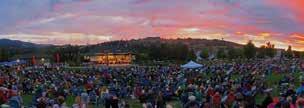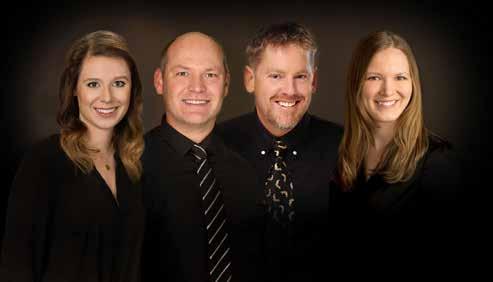












When it comes to the career track taken by Bill Anderson, a loss to the fields of architecture and professional basketball turned into a gain for the Spokane Valley Fire Department (SVFD).

Anderson admits “not being able to draw a stick figure” thwarted his dreams of becoming an architect while height and vertical jump limitations hindered his path to the NBA.
Anderson was delivering car parts following six months of active duty in the U.S. Army at Ft. Ord in California when a delivery brought him to a fire station in Spokane.
“I thought, ‘Maybe I should test for this and become a firefighter,’” Anderson recalls. “At the time, I was kind of lost on what to do.”
When he was 12, Anderson ran to pull a fire alarm when he witnessed a neighbor’s garage on fire. The experience left an impression. He wanted to prevent the same thing from happening to others.
Anderson ended up applying to a different fire department to the east. By the time the city fire HR office called, he had been accepted to join the ranks at SVFD.
The Spokane native would be assigned badge #124 and go on to spend nearly three decades with the department, retiring in 2000 as captain of Millwood Station 2. He was also an active leader of Spokane Valley Firefighters Local 876 and served with the Washington State Council of Firefighters for 25 years as a trustee.
“You’re a firefighter but you’re a member of the team and the team keeps you going,” Anderson said. It didn’t take long after retirement
for Anderson to re-enter the sphere of influence at SVFD as he put his name on the ballot for fire commissioner. He defeated incumbent C. Ray Allen in the fall of 2000 and began serving in January 2001.
Anderson brought administrative experience outside SVFD to his new role, including serving on the West Valley School District Board from 1977 to 1981. He also spent a year as part of the Board of Freeholders, a group that provided input on improving efficiencies in county government.
Above all, Anderson wanted to give back to the department and community he had been dedicated to
for so long.
“I wanted to be involved with the people we served and to those on the job,” he said. “I just wanted to make the fire department as good as it could be.”
After emerging victorious in four elections and serving 24 years as a commissioner, Anderson will step down at the end of 2023, culminating 53 years of service to SVFD. His tenure with the department spans a time that has included 10 different fire chiefs. Only Ron Schmidt served longer as a commissioner.
A trio of candidates – Rick Freier, George Orr and Diana Wilhite – are running for Anderson’s soon-to-be-
vacated position.
“It has been a pleasure having Bill Anderson serve as a Board of Fire Commissioner at Spokane Valley Fire Department,” said SVFD Fire Chief Frank Soto Jr. “He has brought a unique perspective to the board in his many years of service to our community. It is not often a citizen serves for so long. We wish him well as he leaves us in pursuit of the next chapter of his life.”
Anderson grew up in North Spokane and attended Rogers High School, receiving his diploma in 1963. He enrolled at Eastern Washington University after graduation and later enlisted in the Army, serving six months of active duty as part of a helicopter maintenance crew. He would serve later in the Army National Guard.
He returned to EWU later to earn a degree in general studies to go along with an associate’s degree from Spokane Community College.
“I had a grip on the commissioner role when I started,” Anderson said. “I tried to put my two cents in. We were all concerned with benefiting the firefighters and the people of the Valley. I hope people think of me as good person, someone who cared.”
Anderson and his wife Fran have five children, six grandkids and one grandchild in their combined family.
“It’s important to me that we continue the good service we’ve always given the people,” Anderson said. “We’ve accomplished a lot and are pulling in the same direction to get better. I’m very proud of the Spokane Valley Fire Department.”
Q: How did your experience in the Army benefit you as a firefighter?
A: My outlook on life was changed when I served active duty in the Army. I realized I needed to mature and make a plan for my life. It helped me to realize that I had to work harder to complete my education if I was to have the life I wanted. It also showed me the importance of teamwork in any job you have if you want to succeed.



















Continued from page 2
Q: How has SVFD responded to coverage in the Valley as the area has expanded over the years?
A: I started as number 59 on the line with six stations. My group was hired to increase first responders to three on each apparatus. It didn’t take long for retirements and injuries to move us back to two-man companies. As the Valley grew, we came to the conclusion that for the safety of our firefighters and our community, we needed more first responders on duty daily. We then mandated at least three-person crews on pumper apparatus and four on ladder apparatus to do the job.
Q: Are there certain advances in technology since you started in this field over 50 years ago that have been particularly impactful?
A: The job itself is still labor intensive as the training for our people is as well. Since over 80 percent of the fire department calls are for medical emergencies, we now have paramedics on all apparatus if possible. Fire responses have also changed with how we fight fires. If firefighters have to enter a burning building for each two, in there are two more out as well as an emergency rescue group outside. It continues to evolve.
Q: Hiring a qualified fire chief is a key responsibility of fire commissioners. In your opinion, what makes a good fire chief?
A: In my opinion a good fire chief has the respect and backing of all department employees. Communication with the employees and the community is a necessity. The fire chief is aware of the concerns of both the community as well as employees and all partners who work with and serve in the community. Honesty, integrity and good character are a must.
Q: What was the most rewarding aspect for you of being a firefighter? How about as a commissioner?
A: As a firefighter, my greatest reward was a job well-done and the high esteem we held with our community. Even though we were involved in things where lives were lost or people lost everything, we did everything we possibly could to make things better. As a commissioner it is the building of a first-class fire
department. In my opinion SVFD is the best in the state.
Q: There are three qualified candidates running for the commissioner position you will be retiring from. What advice would you give to the person who wins the election?
A: Keep an open mind. You’ll not agree with everything done but you’re one of five on a board with different opinions. Remember that your decisions will be welcomed by some and opposed by others. You’re involved with a million-dollar entity of the public’s money. Choose what you honestly feel is best for all the stakeholders and is a safe path.
Q: Finally, what are some of the most important fire protection measures the general public should be practicing?
A: Have working smoke detectors and please pay attention to fire alerts and safety warnings. Watch for responding vehicles and pull to the right if possible to allow them to pass. Drive safely and don’t hesitate to call 911 for any emergency. Waiting can make it worse.





depict where citizens have reported Vehicle Thefts, Burglaries, Malicious Mischief and Thefts. The Spokane Valley Police Department and the Spokane County Sheriff’s office analyze this data to determine high crime areas and where to allocate resources. Citizens who have been a victim of crime are encouraged to call 911, if the crime is in progress, or Crime Check at 4562233, if not in progress, to report a crime.











Although we have seen unseasonably lower temperatures and more rain, the Spokane Metro Area is still at risk for fire this summer.
Unauthorized open burning and unauthorized recreational fires are restricted until this order is lifted or unless otherwise permitted by law enforcement or authorized agencies. If you have any questions, before lighting any fire, call your local agency first.
With increasing temperatures and our native fuels drying out, please burn carefully.


A few guidelines to follow:
• Only burn in approved devices.



• Have a fire extinguisher and/ or a hose accessible.

• Be kind to your neighbors and only burn clean dry wood.

And, finally, remember to watch for burn restrictions related to our smoke particulate index and air quality. Vulnerable population include younger, and elderly generations, and those with heart and respiratory conditions.

While the burn restriction is in place, any person found with a recreational fire or conducting open burning who fails to take immediate action to extinguish or otherwise discontinue such burning when ordered or notified to do so shall be charged with a misdemeanor. (IFC 109; SCC 3.02)
Spokane Regional Clean Air Agency may further restrict outdoor woodfueled fires based on air quality. Always check current restrictions at https:// spokanecleanair.org/burning/burnrestrictions/ or the Burn Info Hotline at (509) 477-4710.
If you have questions regarding burn restrictions, here are some resources:

Spokane Clean Air - https:// spokanecleanair.org/burning/
Spokane County - https://www. spokanecounty.org/
Spokane Valley Fire Department (SVFD) - https://www. spokanevalleyfire.com/




















Spokane Valley Fire Department (SVFD) crews responded to a total of 1,913 emergency incidents for June 2023.


Fire Suppression 153








Tech Rescue (includes Motor Vehicle Collisions) 95 Other 49 HazMat 22 Wildland Fire 14 Cancelled 1
Of note:


• Emergency Medical Services accounted for 82.54% of all SVFD incidents.

• Fire Suppression (fire and Building Alarms) was 8% of all SVFD incidents.
Media Release June 12, 2023

Spokane Valley Fire Department (SVFD) has received an $18,000.00 grant from State Farm that will now go toward our Enhanced Home Safety Visit Program.
The goal o the program is to:

• Reduce the rate of fire fatalities.
• Increase the number of atrisk homes with working smoke and CO alarms.


• Improve the fire safety of residents and firefighters.
• Reduce the rate of falls in our older adult and disabled populations.
“One objective is to address atrisk homes in our jurisdiction by installing smoke and CO alarms,” said SVFD Deputy Fire Marshal, Brett Anderson. “We will install battery-operated alarms as well as enhance our existing home fire safety program by including hardwired alarms, where needed.”
At-risk homes will be identified by SVFD firefighters during 9-11 calls and during bi-annual smoke alarm "blitzes" where at risk neighborhoods are evaluated for age of home, number of incidents occurring within the area, age of residents living within a community and other fire and life safety factors.
See SVFD REPORT, Page 9
The Spokane Valley City Council voted at its July 18 meeting to provide financial assistance to a new performing arts center taking shape near Mirabeau Point.
The council originally consented at its May 31 meeting to allocate $785,714 of general fund revenue made available for grant purposes by receipt of federal Coronavirus Local Fiscal Recovery Fund (CLFR) money — appropriated through the 2021 American Rescue Plan Act (ARPA) — to the Idaho Central Spokane Valley Performing Arts Center. The center is a project of the Spokane Valley Summer Theatre, which is fundraising for the estimated $48 million, 59,000 square foot facility near the Tru By Hilton Hotel. The theatre will be the building’s main tenant, with Idaho Central Credit Union purchasing the naming rights.
CLFR funding can be used to replace revenue lost as a result of the Covid-19 pandemic. Spokane Valley has received approximately $16 million in CLFR funding, and using a federal formula, calculated about $10.8 million in lost revenue.
The city has primarily used CLFR funds for law enforcement costs, which has resulted in freeing up a corresponding amount of general fund revenue that can be put towards “other projects and community needs.”
“Essentially, it (CLFR) makes this and other general fund grant awards possible,” Spokane Valley accountant and budget analyst Sarah Farr told the council.
After the May 31 meeting, staff negotiated a grant contract with the

Performing Arts Center. The grant is refundable over a 20-year period, and obligates the center to use the money solely for “the purposes of providing musical, theatrical, educational and cultural programming.”
It also incorporates provisions for helping with economic development and tourism in the city, and the Performing Arts Center’s “commitment to providing access and educational opportunities to those below 80% AMI (average median income) and youth through reduced fees and scholarship options.” Beginning in 2025, the center will begin reporting these metrics to the city to measure the grant’s performance.
Dr. Marnie Rorholm, Spokane Valley Summer Theatre Managing Director, expressed the nonprofit’s thanks to the city for the funding, noting the center is on track to open summer 2024.
“This is an enormous project,” she added.
Not everyone was thrilled with the council’s unanimous decision to provide the funding. Spokane Valley resident John Harding questioned why a privately-funded enterprise should get over $700,000 of public money.
Harding said the priorities for the funding should go to essential public services such as police, fire and utilities. While theatre “is wonderful,” he listed off a number of other impacts of “this so-called Covid” that should be in line for the funding.
“The optics of this just make me sick, I’m sorry,” Harding said.
The Spokane Valley City Council unanimously approved additions to
local street repair projects currently underway in the city.
At the July 18 meeting, the council approved an amendment to the existing contract with Poe Asphalt allowing the company to perform additional local street repairs coinciding with gas service upgrades being done by Avista Utilities. Avista started these upgrades last year, and the work has resulted in some degradation to existing surface streets that were already in need of work.
“So, we would like to get in there and repair the roads in totality from curb to curb,” Community & Public Works Director Bill Helbig said.
The amendment adds $317,209 to Poe’s $1.567 million contract for this work. The sections to be completely rebuilt are Koren Road from Rocky Ridge Drive to 16th Avenue, Rocky Ridge Drive south end to 16th and 19th Avenue east of Rocky Ridge Drive. The city and Poe Asphalt will conduct the repair work, with Avista reimbursing the city for $132,416 of the extra costs.
At its July 11 meeting the council approved a $345,000 change order to its Local Access Preservation Services contract with Inland Asphalt Paving to repair three additional streets in south Spokane Valley. The original $1.5 million contract was approved by council in March using a new “unit rate” method for determining project costs.
Using his authority under the contract, City Manager John Hohman increased the amount by $224,000 to pay for additional improvements. To date, 33 street sections have been repaved at a cost of just over $1.753 million.
The council-approved increase will pay for $29,152.38 of overages from the first increase, and the additional street repaving, including stormwater and concrete flatwork, of portions of East 27th Avenue and Tall Tree and MacDonald roads. Just over $1.94
million of the work is paid for through the solid waste contract local road wear fee, with CIP Engineering Manager Rob Lochmiller telling council a low bid on street work in the Summerfield neighborhood helped free up more funding.
Future construction, funding search, approved
Also at the July 11 meeting, council unanimously approved awarding an almost $1.55 million contract to N.A. Degerstrom, Inc. for improvements to the North Pines Road/Mission Avenue intersection. Work includes stormwater and sidewalks, existing signalization with a southbound right turn and two eastbound left turn lanes added, along with new signalization.
The project is 37.9% higher than the $1.124 million engineering estimate, mainly due to construction being extended to 2024. Lochmiller told the council the delay stemmed from added requirements associated with federally-funded projects, which the intersection is, right-ofway negotiations with property owners that were wrapped up late in the construction season and some materials that require 4-5 months lead time for shipment.
Council also approved a staff request to apply for funding from the state Transportation Improvement Board’s (TIB) Urban Arterial Program (UAP) and the Active Transportation Program (ATP) for three proposed city projects. The city is seeking $2.08 million from the UAP for the $2.6 million Barker Road/8th Avenue roundabout project and $3.24 million for the $4.5 million Argonne Concrete Reconstruction from Indiana to Knox project.
Additionally, the city is seeking $504,000 from the ATP for the $700,000 Sprague Avenue Pedestrian Crossings near Chronicle and McKinnon-Howe streets (near stores such as Wal-Mart, Costco and Home Depot). All three projects require city matching funds.


Continued from page 7
Another objective is to address the increasing number of “falls” calls SVFD responds to.
“Our number one 9-1-1 call for the past three years has been for falling,” said Community Risk Reduction Specialist, Caroline Kusher. “Older adult falls are preventable and there are several strategies to help reduce the risks associated with falls, one of which is to modify the home environment.”
ADA grab bars are a way to reduce falls in our community. These grab bars can be installed in the homes of disabled residents as well as older adults living within the SVFD Fire District. At-risk residents will be identified during 9-1-1 calls, referrals through C.A.R.E.S. (Fire Community Assistance Response Team), and residents who register via phone or online at spokanevalleyfire.com. Grab bars will be installed by Spokane Neighborhood Action Partners (SNAP), who currently provide over 30 community programs, including housing improvements.
Residents can register for an Enhanced Home Fire Safety visit appointment via phone or online registration.

The Spokane Valley Fire Department (SVFD) proudly unveiled Engine 5, the newest addition to our fleet, in a traditional push in ceremony at Station 5, 15510 E. Marietta Ave on June 15th.
Engine 5 joined our Water Rescue Team at our recently renovated Station 5, serving citizens and businesses in the Sullivan neighborhood and industrial area.

The new Engine 5 will replace the previous Engine 5 (a workhorse of our fleet for 16 years), a 2007 Seagraves that had close to 164,000 miles on it.
The new addition helps SVFD better respond to the growing number of incidents while increasing safety in our community.
SVFD is committed to placing the right resources in the areas they’re needed most.
The Spokane Valley Fire Department (SVFD) serves a population of 142,000+ over 75-square miles, including the cities of Spokane Valley, Liberty Lake, and Millwood, as well as surrounding unincorporated areas. In 2021, our cross-trained Firefighter/EMTs and Firefighter/Paramedics responded to more than 23,235 emergency calls.

Established in 1940, SVFD is committed to pursuing excellence and is distinguished as an accredited agency by the Commission on Fire Accreditation International (CFAI), and by SVFD’s Class 2 fire insurance rating from the Washington Survey and Rating Bureau

Connect with SVFD at: spokanevalleyfire. com. For department news, safety information, and timely updates, find us on Facebook, Twitter, Instagram, LinkedIn, and YouTube.

 By John McCallum Current correspondent
By John McCallum Current correspondent
Thanks to a collaborative effort between students, parents, school district teachers and staff and — most importantly — voters, Freeman School District is on track to have one of the nicer, more modern sports facilities for a district of its size in the Spokane area.
School District Superintendent Randy Russell said the project is the next step in the master plan for modernizing the entire school complex started with passage of a $19.5 million, 20-year bond in 2008. The measure passed with a 65.8% voter approval, and enabled modernization of the high school and elementary school, along with middle school improvements, a new transportation facility and district offices.
“We’ve been taking on a new project for 10 of the last 12 years,” Russell said.
The latest is the $2.65 million sports complex — funded by passage of the Capital Facilities Replacement Levy in 2021. The first portion is modernization of Kent Smith Field, the football / track
and field stadium.
Russell said the work is being done in three phases, the first of which is underway and slated to be completed by the Scotties first football game on Sept. 1. Phase 1 involves removing existing grass and dirt and installing synthetic field turf, along with improved lighting and other infrastructure needs such as drainage, fiber optics and WiFi.
Phase 2 will feature improvements to the bleachers along with storage upgrades while Phase 3 will provide more storage and additional features.
Russell said the district is using a design / build format for the sports complex project. While other area districts such as Cheney have done design / build — where the customer, project manager and general contractor collaborate on design of a project — Russell believes Freeman is the first in the area to utilize this for sports fields.
All companies involved are local, headed by project manager OAC and general contractor Garco Construction. AM Landshaper is providing the ground work, with Coast to Coast Turf supplying and installing the turf and Triumph Electric doing lights and other wiring requirements.
The process began with removing 14 inches of soil from the interior of the stadium’s track — with over 300 dump truck loads of dirt transported to another location on the district complex for reuse.
A cement powder known as Cement Base Treatment (CBT), was then rototilled into the exposed soil with a Star Wars-looking machine followed by rolling and grading the resulting surface to provide a foundation. Russell said the rototilling usually requires hundreds of thousands of gallons of water in the
process, but only required thousands of gallons due to the nature of the clay soil underneath the district complex.
The CBT foundation was then overlaid with 10 inches of rock, followed by 4 inches of sand and a pad for the turf. The turf itself, Root Zone by AstroTurf, was then rolled and fitted into place.
Besides reducing the need for irrigation and other maintenance, the newer version of synthetic turf is more durable and results in fewer injuries than original AstroTurf due to its use of compounds such as recycled rubber

products.
Russell said the need to move forward with the stadium turf project became evident this past fall when the Freeman football team and girls soccer team qualified for the state playoffs — but were unable to host games because early winter weather conditions had made the field unplayable. The teams ended up playing at University High School in Spokane Valley.
Russell said the field turf will save the district money and stress on its water supply by reducing the need for irrigation and other forms of maintenance, which runs about $60,000 a year.
“The savings here will go to future purchase of new turf, which will likely be needed in 12 – 15 years,” Russell said. “That will involve putting the new carpet over the existing, which will take care of us for the next 25 years.”
The district is also working on improvements with its middle school fields through utilizing new maintenance techniques. One of these is “fraze” mowing, a process used in Europe since 1996 and recently employed in the U.S., including locally at Gonzaga University, Washington State University and Mead School District.
According to information from the Foundation for Safer Athletic Fields, the process involves a special rotary tiller that removes the top 2 inches of turfgrass surface. This allows for removing thatch, black and incompatible soil layers, shallowly rooted weeds and weed seeds to leave turfgrass roots, rhizomes and crowns with a better ability to regenerate.
The district is also using the dirt removed from the interior of the stadium in other areas to level slopes and fill in areas to create more playing surfaces. All the work being done will be utilized not only by sports teams but by physical education classes and other school activities.
Russell said “teams of people” have worked on the project. District staff members selected on project committees have analyzed mounds of information and toured other facilities to learn best practices, while students and parents conducted interviews of turf contractors.
Russell believes that process helped vest the community in the work, and should lead to better facilities in the long run.
“We learned a lot ahead of time,” he said. “It saved us time. It saves us heartache. It saved us money, which is good.”
After more than a year of open houses, meetings and discussions, the Central Valley School District board of directors have approved a new five-year strategic plan to provide a road map for everything from computer systems to student learning.
In addition to staff and administrators, the district also sought input from students and parents. “We wanted to have representation, solid representation, from our students,” said Superintendent John Parker. “We wanted to have a voice from parents and parent groups. People are very vested in their children’s education.”
Other community groups, including local businesses and the Greater Spokane Valley Chamber of Commerce, were also consulted. The question posed to everyone was simple: what do students need to feel prepared for their future and to thrive academically, socially and emotionally?
“We kept it pretty broad,” he said. “Based on that, ideas flowed.”
After data and community input was gathered, a 27-person core planning team was assembled to determine the bones of the strategic plan. The team included students, parents, alumni, teachers, administrators and community members in addition to representatives from local businesses and colleges. The basics of the plan identified by the planning team was then further refined by an executive team that included principals, administrators and two school board members.
The new strategic plans identifies four key directions for the district: pursuing a culture of belonging and equitable opportunities for all, reimagining systems and structures, prioritizing district-wide support for the whole child and launching infinite possibilities. The district’s mission and vision statements were also updated.

“We really feel these are 21st century statements that say who we are,” Parker said of the vision
statements.
The key to any school and any school district is to make children feel like they belong, Parker said. Research shows that if children feel like they belong, that they are welcomed, their learning will improve and they’ll succeed academically.
Another key tenant is to make sure that students in all parts of the 80-square mile district get the same educational opportunities no matter which school they attend. With that goal in mind, the district is being broken into three smaller community-oriented areas called the Western, Central and Eastern Learning Communities. Each learning community is centered around the elementary and middle schools that feed into the district’s three comprehensive high schools.
The district has launched a new CVSD Link newsletter and plans to host Community Link events in each of the three Learning Communities this fall. It’s not like we’re trying to create three smaller school districts within the school district,” Parker said. “It’s almost like creating three houses. We’re giving identity to that.”
As part of the new emphasis on building community, the district
will change how it offers preschool classes for children ages 3-5. Previously, all classes have been held in the district’s Early Learning Center on East Sprague, but preschool classes will also be offered in one elementary school in each of the three Learning Communities.
Parker said he wants to expand the work the Early Learning Center has been doing to include students with diagnoses such as autism and ADHD into the classroom. “We are doing preventative and inclusionary work,” he said. “When they hit kindergarten, they already have skills above and beyond other students to self-advocate.”
Changes have also been made at the administrative level. The district no longer has a director of elementary education and a director of secondary education. Instead, there are new academic officer positions for each of the three Learning Communities. “They are going to be leading the charge in the big picture,” Parker said.
The new strategic plan touches nearly all areas. It calls for recruitment and retention of highly qualified staff, equitable resource See STRATEGIC PLAN, Page 22


As a standout student and athlete, Kate Schneider stands tall for Scottie Nation. The incoming senior at Freeman High School maintains a 3.98 grade point average and is secretary of the school’s chapter of National Honor Society. As a member of Future Business Leaders of America, Schneider has placed in the top 10 in national competition in three categories. She is president of the Freeman FBLA chapter. Schneider has earned first team All-Academic honors in volleyball, basketball and tennis. She was a second-team All Northeast A League volleyball honoree and part of a U-17 club squad that competed in nationals this summer. She was a reserve on the Scotties’ basketball team that placed sixth in state in 2022 and part of a volleyball squad that was fifth at state in 2021. Schneider was named all-league in tennis as a junior.


Kanoa Rogan represented Freeman High School with a flourish at the 1A state track meet. The incoming senior placed fourth in the pole vault, seventh in the long jump and was part of a Scotties’ 4 x 100-meter relay team that finished eighth. He also qualified in the 100 meters. Rogan took first at regionals in the long jump and 4 x 100 and second in the pole vault. He will be part of Spokane Speed Academy this winter. In football, Rogan was part of a Freeman squad that advanced to the state semi-finals. He averaged 5.52 yards on 81 carries as a running back, piling up 447 yards and six touchdowns for the season. He was selected to the All Northeast A League second team. Rogan maintains a 3.79 grade point average and is part of National Honor Society.

A 1984 graduate of University High, Jennifer Wilcox has gone on to titan accomplishments. She served nine years in the Air Force after completing a degree in Information Systems at the University of Idaho, rising to the rank of captain. Wilcox supports fellow veterans as part of the Eastern Washington Veterans Task Force and has taken part in the Spokane Veterans Forum. She is a volunteer with the Greater Spokane Substance Abuse Council, contributing to the DUI Impact Panel and other efforts. The Spokane Valley resident is also part of the Spokane Regional Continuum of Care focused on ending homelessness. She has volunteered with the Point in Time Homeless Count and is a member of the Greater Valley Support Network. “I really feel it’s my duty to give back because I’ve been very fortunate and had people help me,” Wilcox said.

 By John McCallum Current correspondent
By John McCallum Current correspondent
A Spokane Valley aquatic activities fixture is poised to make a return — even if it is only for a short time this year.
Splash Down Family Water Park has been drained of water and customers for over three years now, but new owners F.W. Holdings, LLC are hoping to change that soon. FW Holdings principal Brandin Olson purchased the 41-year-old water park in May, and since then has been busy trying to check-off all the requirements needed for opening — which are many.
Not least of these was entering into a new lease agreement with the city of Spokane Valley, who owns the land the water park sits on. The City Council unanimously approved the new agreement at its June 20 meeting, making some changes to an agreement signed in 2018 with the previous owners, New Splash-Down Concessions, that could prove more favorable to the long-term viability of the park.
“There’s a little bit of flexibility built in to try to allow him (Olson) to grow the business as best as possible, and of course keeping the privilege with the city to determine what’s appropriate and protect our interests,” Parks & Recreation Director John Bottelli told the council.
The park, which is located just north of the pool and splash pad at Valley Mission Park, originally opened in 1982 and was owned and operated by The Bleasner Group. Primary contact and shareholder Bill Bleasner originally entered into a contract to lease the land from Spokane County, renewing the lease in 2002 for another 10 years.
When Spokane Valley incorporated in 2003, the lease was turned over to the city, with Bleasner eventually selling the operation to
Geoff and Melissa Kellogg in 2005. In 2009 the city entered into a new lease agreement with the Kellogg’s that simplified payment terms, and in 2012 an amended lease agreement that reduced the annual fee from $43,000 to $20,000 due to changes in “local market conditions which neither party had anticipated.”
The Kelloggs eventually sold the operation back to Bleasner in 2018, who renamed the entity New Splash-Down Concessions. A new agreement with the city dropped the annual fee to $15,000.
The park was not able to operate in 2020 due to health restrictions imposed as part of combating the Covid-19 pandemic. The council waived payment of the annual fee because of the closure in 2020, and in 2021.
The park was not able to open in 2022 due to a number of factors, including vandalism to the facility, declining operating conditions and the death of the primary owner in 2020. As such, the council waived the annual fee while the surviving owners decided what to do with the park — eventually selling it to Olson and FW Holdings, LLC.
Olson was born and raised in Spokane Valley, and spent many hot summer afternoons with friends
at Splash Down. Having relocated back to the area with his family, he said every time he drove by the shuttered facility he was reminded of those times and the role the water park could play in providing safe, healthy physical activities for kids.
He made some inquiries about purchasing the park, at first meeting with little results. He was finally able to contact and meet Bleasner’s daughter, Heidi Shutts, who was one of the principals in New Splash-Down Concessions, and a purchase agreement was eventually hammered out between the parties.
“It would be sad to see that place go away,” Olson told the council. “I think the Valley needs it.”
The new lease agreement provides several conditions that could help the park become profitable, and thus capable of remaining in business for a long period of time. First, it sets a scaled annual fee payment schedule of $1,000 in 2023, $3,000 in 2024, $7,000 in 2025, $10,000 in 2026 and $15,000 in both 2027 and 2028.
“If the business is doing well, of course we would look at taking a closer look at those numbers and potentially bring back a different base rental amount for the second (lease) term,” Bottelli said.
The agreement also allows F.W.
Holdings to provide services beyond those related to recreational water slide operations, after first seeking and receiving approval by the city. It would also allow Olson to request the city provide water service to Splash Down even if it has turned off such service to Valley Mission’s pool, allowing the water park to operate outside of the normal pool season.
Olson said when he took possession of the facility, he found it was in worse condition than the previous owners had anticipated. A lot of work has been done to repair the slide operations, including cleaning up graffiti and providing additional security.
“One night, we caught 20 people in the park,” he said.
Preparations to hopefully open the park later this summer continue. Olson said in a recent phone interview the repair work to the facility had passed inspection by city officials, and that arrangements for insurance were pending finalization of contracts.
While the summer swimming season is nearing its end, Olson said they were still hoping for the possibility the water park could still open, even if for a short period of time.







The Heroes Garden at the Spokane Vet Center, designed to be a place of respite for veterans and Gold Star families, is getting a new addition in August as several local chapters of the Daughters of the American Revolution come together to sponsor a Never Forget flower bed.

The large garden sits behind carved metal gates behind the Vet Center on Mirabeau Parkway across from Mirabeau Point Park. More than a dozen raised beds are filled with everything from vegetables to flowers and raspberry bushes line the edges. An Eagle Scout built a fountain that sits on one side. Pear, apple and cherry trees grow next to a gazebo and there are plenty of benches placed throughout the garden to provide a place to sit and chat or be reflective.
“Sometimes people come in and just need a little space,” said Keirsten Lyons of the Washington State Fallen Heroes Project, which maintains the garden.
The new Never Forget flower bed includes an engraved stone, a plaque and Never Forget rose bushes that were created just for the Daughters of the American Revolution. The Spokane Garry,

Jonas Babcock, Esther Reed and May Hutton chapters of the DAR are sponsoring the garden bed along with the Society of the Honor Guard Tome of the Unknown Soldiers and the Washington State Fallen Heroes Project.
The Never Forget flower bed will be unveiled during a public ceremony at 11 a.m. on Aug. 5.
Lyons, in addition to running the garden, is also a Gold Star mother. Her son Jake died in Afghanistan nine years ago while he was serving in the U.S. Marine Corps. She is part of a group of volunteers who come and maintain the garden every Tuesday and finds working in the garden therapeutic. She also finds joy in seeing the peace and comfort it brings others.
“For most of us, Tuesdays are our favorite day of the week,” she said. “Honestly the best part is just watching other people enjoy the space. That’s why we do it. That’s why we come out and pull weeds every week and plant pretty flowers.”
The garden was put in shortly after the Vet Center opened a dozen years ago, but after a few years it fell into disrepair. Lyons said the Washington State Fallen Heroes Project was asked to take over the maintenance of the garden around the time the COVID-19 pandemic hit. At the time, veterans who received counseling at the center were having to meet with their counselors over Zoom.
“We came in and got the garden back under control and gave them a
place to meet face to face safely,” she said. “This place has gone through quite the evolution. The weeds were about chest level all the way through.”
While holding counseling sessions outside is no longer a requirement, some veterans still choose to have their sessions in the calmness of the garden, Lyons said. “We encourage people to come out here,” she said. “A lot of people still meet out here.”
Charlene Hawley began attending grief counseling at the Vet Center soon after her son Daniel, a recruiter in the Army National Guard, committed suicide in 2011. Though she doesn’t attend counseling sessions anymore, she still comes to visit the garden. “Anytime you have someplace you can come and relax and just be yourself it’s worth it,” she said. “We get together and sometimes there’s lots of crying, but no one tells us to stop crying.”
Patches Cox, a Department of Defense contractor with Survivor Outreach Services, is one of the volunteers who helps maintain the garden. She said that she likes that it provides a place for veterans that is more calming and welcoming than an office. Sitting down on a bench or at the picnic table while surrounded by a garden is just easier, she said. “It’s just a nice setting where you can just chat,” she said. “It’s therapeutic. No stress.”
The peace and calm offered by the garden isn’t only for those served by the Vet Center, it helps the volunteers as well. “It’s just a wonderful place,” Lyons said. “There’s something very
therapeutic about getting your hands in the dirt.”
Having something to do in the garden can also make it easier to have conversations. “There’s a lot of hard stories here,” Lyons said. “It’s hard to sit down and talk about stuff, but when you’re pulling weeds together and planting seeds together it’s easier.”
Veterans and Gold Star family members can adopt one of the raised beds in the garden at the beginning of the year. They can choose to plant whatever they want and are in charge of weeding, watering and harvesting. If a bed isn’t adopted, it’s planted as a community bed, Lyons said. Usually those are planted with tomatoes, zucchini and other vegetables and maintained by the volunteers. After the vegetables are harvested, they’re brought inside for veterans who have appointments at the Vet Center to take home with them.
The Heroes Garden is always looking for volunteers to help maintain the garden, Lyons said. “It really is a community endeavor,” she said. “We will never turn away weed pullers.”
Volunteers work in the garden every Tuesday from 9 to 11 a.m. Anyone interested in becoming involved can email Lyons at honoringheroes@wafhp.org.
Working in the garden is something that Lyons highly recommends. “It just takes you away from real life for a few hours every week,” she said. “It’s just a nice respite.”













When he arrived in the Inland Northwest to become manager of the Spokane Indians in 2007, Tim Hulett brought luggage filled with baseball experience.

The Illinois native was a threesport star at Lamphier High School in Springfield and was good enough as an infielder to be drafted in the 39th round by the Texas Rangers in 1978. He initially passed on the professional route, opting to enroll at the University of South Florida in Tampa and later playing at Miami Dade Community College, a school that produced notable pros like Bucky Dent, Steve Carlton and Mickey Rivers.
Hulett was drafted by the Chicago White Sox in 1980 and made his big-league debut in 1983. It was the beginning of a 12-year career in the majors that included stops in Baltimore and St. Louis and saw the utility player hit .249 and post a .962 fielding percentage.
Hulett’s pro journey also included less-glamorous stints with minor-league teams like the Iowa Oaks, Denver Bears and Rochester Red Wings. Between 1980 and his retirement in 1995, Hulett was part of eight minor league rosters in leagues ranging from short-season single-A to triple-A.
“The minor leagues are so tough,” Hulett said. “But I never once thought I wasn’t going to make it to the big leagues. It helped me survive the tough times.”
Hulett was the baseball equivalent of the gym rat, showing up before his teammates for games and taking extra batting practice.
“It wasn’t a job for me,” he said.

Hulett played five years in Baltimore as a teammate of Cal Ripken Jr., baseball’s modern-day Iron Man who would eventually break Lou Gehrig’s record of consecutive games played. Ripken Jr., who suited up for 2,632 games in a row, was elected to the Baseball Hall of Fame in 2007.

“Cal showed up every day and took infield every day,” Hulett said. “Every guy on the team looked at that and knew they had to work that hard.”
Hulett said the decision to play college baseball for several years before starting his professional journey paid dividends.
“You develop more responsibility,” he said. “I didn’t have all that free time and developed more maturity. I learned from my older teammates at South Florida.”
As manager of the Indians, Hulett saw a variety of players populate the roster, from recent high school graduates who signed high-dollar bonuses, to more seasoned players from Division 1 colleges to skilled arrivals from countries like the Dominican Republic and Venezuela.
“I would tell the guys, ‘Some of you have money and some of you don’t, but out on the field we’re a team,” Hulett said.


The money side of baseball shifted dramatically during the course of Hulett’s career. In 1980, the year he signed with the White Sox, the No. 1 overall pick in the draft, Darryl Strawberry, received a $152,500 signing bonus from the New York Mets. By Hulett’s retirement year of 1995, the top pick, Darin Erstad, collected nearly $1.6 million from the California Angels.

The No. 1 pick of this year’s baseball draft, Paul Skenes, a righthanded pitcher from Louisiana State University, signed with the Pittsburgh Pirates for a record $9.2 million.
Hulett’s most lucrative annual salary came in 1994 with the Orioles when he earned $550,000.
While the short-season A level was recognized as a stepping stone to the majors, Hulett said he developed expectations for winning as a manager.
“Yes, you’re there to develop






players but you want to develop players who are focused on winning,” he said.

Spokane Indians Senior Vice President Otto Klein recalls Hulett as “wise and practical” in his decade with the club.
“I think Tim always had the players’ respect,” Klein said. “He was personable and approachable but he would also send messages. One time, a player didn’t hustle down the firstbase line and Tim benched him for three days. I remember Tim saying, ‘He’ll learn by not playing.’ He created accountability with his team.”
When it came to the ingredients necessary to make it to “The Show,” Hulett let his team know that he had traveled that road. Only around 10 percent of minor league players will ever be part of a major league roster.
“Most of the time, we addressed it as a team,” he said. “I would ask them, ‘What are you going to do that’s going to separate you from all those other players?’ I told them I’d been where they want to get. I know how much work it’s going to take.”
Hulett led the Indians to their last Northwest League championship in 2008. He was named NWL Manager of the Year that season as well as in 2010. He currently resides in Louisiana with his wife Linda and coaches at Evangel Christian Academy in Shreveport, a program he has led to five state titles.
Two of Hulett’s sons – Tug and Jeff – played at Evangel and were drafted into pro baseball. Tug logged 67 career at-bats in the majors with the Seattle Mariners and Kansas City Royals after excelling at Auburn University. Jeff played at Texas A & M before spending several years in the Houston Astros minor league system.
Hulett produced a fair share of major leaguers during his tenure in Spokane. The list includes Kyle Hendricks (Cubs), Mitch Moreland (Rangers), Isiah Kiner-Falefa (Yankees), Joey Gallo (Twins), Dylan Moore (Mariners), Derek Holland (Rangers) and Rougned Odor (Padres) among others. There are currently 19 former Spokane Indians on MLB rosters.
“I always felt accomplished when a player got called up,” Hulett said.











Eagle Rock’s Phase II is now fully operational, and with over 100,000 square feet of new indoor storage space, we would be honored to assist you with your storage needs. With a state-of-the art security system, extra wide drive aisles, and exceptional customer service, we have you covered with sizes from 12 x 24 to 18 x 50. All storage units have electricity available as well as extra wide and high doors for your RV, boat, or any of your toys. We also have easy-access outside parking available. Check us out on our website, give us a call, or come visit and let us show you around.


Conveniently located between Coeur d’ Alene, Id and Spokane, Wa on Beck Road one mile north of I-90.



(Idaho Exit 1)

You can help a child improve their reading skills and gain confidence as a reader when you volunteer as a reading buddy. If you love reading and enjoy spending time with kids, consider volunteering.
The Reading Buddy Program pairs volunteers, as mentors, with elementary school students. Each reading buddy volunteer meets with a student once per week for eight weeks at the elementary school, either before or after the school day, to read together one-on-one and foster a love of reading.
The requirements for volunteers include the following: you must be age 16 or older, provide consent to a background check, attend an
Young people ages 6–18 can ride Spokane Transit buses for free with an STA Rider’s License, available now at the library.

The Rider’s License is a bus pass that allows kids to ride STA buses for free year-round until they turn 19 years old. These passes are for ages 6 through 18 (kids under age 6 already ride free).
The Rider’s License is free—just stop by the library with an ID (your library card counts!) and ask for the STA Rider’s License at the service desk. The passes are also available by visiting LINC, our mobile library.
You can pick up an STA Rider’s License at Spokane Valley Library (22 N Herald Rd) and Argonne Library (4322 N Argonne Rd). Passes are also available for pick up at the following libraries: Airway Heights, Cheney, Medical Lake, Moran Prairie, North Spokane, and

orientation, commit to at least one eight-week session, and apply online at www.scld.org/volunteer.
The next Reading Buddy session starts in fall 2023, and the Reading Buddy Volunteer Orientation for that session takes place online at 9am on Saturday, August 5.
During the orientation, we discuss how you can help a child improve their reading skills and gain confidence as a reader. We also go over the Reading Buddy and volunteer program in detail, including what to expect when visiting an elementary school and

onboard LINC.
STA Rider’s Licenses can also be requested through the STA Youth and Student Passes web page at www.spokanetransit.com/fares-
meeting a student, how to choose a book that’s a good fit for the reader, and how to read with your student. Registration is required for orientation, and you can sign up at www.scld.org/ reading-buddy-orientation.
If you have any questions about volunteering for the Reading Buddy Program, please contact me by phone at 509.893.8408 or by email at mboerner@scld.org.
I hope you consider volunteering with the library to help young students improve their reading and learn to enjoy it as well.
passes/student-passes/. You can find out more about the Rider’s Licenses and STA bus routes at Spokanetransit.com.

Explore unbiased ratings, reviews, and comparisons on thousands of products, including home and garden products and tools, cars, appliances, electronics, and more.


The Current is committed to serving the Greater Spokane Valley area through excellent community journalism. We can’t do it at all without you, our readers, and we can’t do it for long without support from our advertisers. Please thank our business partners and look to them when offering your patronage.

Our sincere appreciation to the following businesses for their foundational partnerships withThe Current and its partner publications:
Continued from page 11
distribution, auditing attendance trends, increasing district level support for students and expanding educational opportunities for gifted students and those interested in a Career and Technical Education path.
Some goals that seem simple on their face, such as analyzing grading practices, will actually take months if not years to study and then enact any changes, Parker said. Other goals, such as increasing career pathways for middle and high school students through CTE classes, have become more important in recent years. It’s important to work on eliminating the stigma that some have toward not getting a college education, Parker said. Trade schools and apprenticeships offer pathways to well paying jobs without requiring a college education.
“We want to open doors,” he said.
The goal is to help determine what option is the best for each student, Parker said, whether that is college, community college, enlisting in the military or learning a trade.
Following
Another goal of the strategic plan is to explore a more balanced school year calendar and whether or not to revise bell schedules to maximize learning. The current school year calendar crams 180 days of instruction between Labor Day and mid-June, Parker said. The district is interested in seeing if it would be beneficial to start school a few days earlier and/or end a few days later in order to add in more multi-day breaks for students and staff, he said.
“We’re not looking at adding school days, but can we redistribute them,” Parker said.
Parker said he wants to determine if the current schedule is what works best for students and teachers and if changing it would improve people’s mental health. “We know there’s some interest out there in this,” he said.
However, no changes would be made until the issue is studied thoroughly and input is received from parents and students, Parker said. In making its decision the district would also have to consider issues such as daycare and transportation, he said.
EDITOR/PUBLISHER Ben Wick ben@libertylakesplash.com
CO OWNER Danica Wick danica@libertylakesplash.com
CIRCULATION Larry Passmore circulation@libertylakesplash.com
CONTRIBUTORS Nina Culver, Craig Howard, John McCallum
The Valley Current P.O. Box 363 Liberty Lake, WA 99019
Phone: 509-242-7752
www.valleycurrent.com
The Current is published monthly by or before the first of each month. It is distributed free of charge to every business and home in the greater Spokane Valley area. Copies are located at drop-off locations in Spokane Valley, Liberty Lake and the surrounding area.
The Current is brought to you by
Submitted materials
Announcements, obituaries, letters to the editor and story ideas are encouraged. Submit them in writing to publisher@valleycurrent.com. Submissions should be received by the 15th of the month for best chance of publication in the following month’s Current.
Subscriptions
Subscriptions for U.S. postal addresses cost $20 for 12 issues. Send a check and subscription address to P.O. Box 363, Liberty Lake, WA 99019. Subscriptions must be received by the 15th of the month in order for the subscription to begin with the issue printed the end of that month.
Correction policy
The Current strives for accuracy in all content. Errors should be reported immediately to 509242-7752 or by email to editor@valleycurrent.com. Confirmed factual errors will be corrected on this page in the issue following their discovery.
Advertising information
Display ad copy and camera-ready ads are due by 5 p.m. on the 15th of the month for the following month’s issue. Call 509-242-7752 for more information.
Advertising integrity
Inaccurate or deceptive advertising is never knowingly accepted. Complaints about advertisers should be made in writing to the Better Business Bureau and to advertise@valleycurrent.com. The Current is not responsible for the content of or claims made in ads.
Of note: This thank you message was produced by The Current’s advertising team, which works its tail off on behalf of partner businesses, helping them share their messages through advertisements. This is an independent function from The Current’s editorial team, which has its own evaluation process to determine the community news stories and features it pursues. For more information about a win-win partnership that expertly markets your business to thousands of readers (while making this home-grown community newspaper possible), email advertise@valleycurrent.com. With story ideas, contact editor@valleycurrent.com.
Though working through the strategic plan will take years, Parker said it will be worth the effort. “I would much rather think big over a longer term than think small,” he said.
Copyright © 2023
All rights reserved. All contents of The Current may not be reproduced without written permission of the publisher.
Life-long resident, successful entrepreneur and overall friend of everything Spokane Valley, Jack Pring passed away on June 19, 2023. Pring passed with family nearby at the age of 92.
Born Jan. 21, 1931 in Spokane, Pring grew up in a home on Argonne Road. He graduated from West Valley High School where he was elected school president and captained the football, basketball and track and field teams.
It was also at West Valley where he met his future wife, Donna Christensen. The couple eventually married on June 28, 1953, and together had four children: Jock, Susie, Tim and Brad.
Jack Pring continued his post-high school education at the University of Idaho and at Washington State College (eventually Washington State University). He subsequently enlisted in the U.S. Coast Guard during the period of the Korean War, serving aboard the 255-foot USCG Winona.
Named after Winona Lake, Indiana and based out of Port Angeles, Wash., according to the Coast Guard website, the Winona “was assigned to ocean station patrols, Bering Sea patrols, fisheries patrols and other law enforcement operations as well as search and rescue duties when needed. She typically served on Ocean Station November, mid-way between San Francisco and Hawaii, and Ocean Station Victor, midway between Hawaii and Japan.”
After serving in the Coast Guard, Pring returned home to pursue a dream of a career in the cattle industry. Having grown up riding horses cared for by his parents, father John Pring Sr. and mother Pauline, at the home on Argonne, Jack Pring moved to the Lewiston-Clarkston area where he worked on a cattle ranch.
Living in a trailer near Clarkston — complete with rattlesnakes at
times taking residence underneath — Brad Pring said his grandfather paid Jack a visit.
“He went to him and said, ‘What are you doing?’” Brad Pring said.
The elder Pring convinced his son to abandon the cattle business and come work for him at the automobile dealership, Appleway Motors, he established in 1928 in Spokane Valley. Here Jack Pring found a calling, turning the dealership from a 100 cars sold per year to 1,500 cars sold in his first year alone.
Jack Pring took over ownership of Appleway Motors in 1955, and his sales success led to his eventual selection as a dealer representative on the Chevrolet National Dealer Council at the age of 28.
Brad Pring attributed his father’s success to his convictions that
people coming to the dealership were more than just customers.
“His commitment was that a good deal always makes friends,” Pring said, adding his father believed a good negotiator was also a good listener and honest, always making sure people knew where they stood.
“He truly cared about people,” Brad Pring added.
The dealership expanded and eventually became the Appleway Automotive Group. In 1960, Jack Pring founded the Pring Corporation, which has developed a number of retail and office properties throughout the Northwest such as the F&M Center retail building at 509 N. Sullivan Road, opening in 2004.
In January 1981, Jack Pring returned to his love of horses by buying the then financially failing Playfair Racetrack in Spokane Valley, saving the facility operating since 1935 from being demolished. Jack and Brad Pring tried to operate the track as a familyfriendly enterprise, eventually leasing operation of the facility to
other interests in 1988.
“He once said the first thing he learned to read was a racing form,” Brad Pring said, adding that at one point his father took to riding a horse from his home on 20th Avenue down Dishman-Mica Road to the racetrack for work.
“He was always a cowboy at heart,” Brad Pring said.

Playfair closed for good in 2000. It was torn down and eventually developed into a commerce park being its original name.
Pring served with a number of Spokane Valley and area organizations, sometimes on the board of directors or as president. These organizations included the Spokane Humane Society, Spokane Interstate Fair Board, the Boys and Girls Club of Spokane County and the Central Valley School District Board. He also partnered to help other organizations, such as the Spokane Youth Sports Association with a $20,000 loan in 1985 to help set up a bingo operation at Playfair, with proceeds supporting the association’s programs.
Jack Pring is survived by his wife Donna and three children, along with 10 grandchildren and 15 great-grandchildren. His parents, sister Donna Gillis and son Tim preceded him in death.
Brad Pring said his father felt he was fortunate to be in a position to take advantage of a number of opportunities presented to him over his lifetime, including being witness to several historical events such as the opening of the Chunnel between Britain and France in 1994, and wanted others to have those chances too.
“As a son, he gave absolutely every opportunity to his family,” Brad Pring said.
A Celebration of Life was held for Jack on June 28 at Mirabeau Park Hotel and Convention Center. Brad Pring said that among the many people who spoke about his father at the event, one aspect of Jack Pring seemed to always show through.
“It didn’t matter who you were in that room, everybody thought they were Jack Pring’s friend, and he was theirs,” Brad Pring said. “He was there for everybody.”



